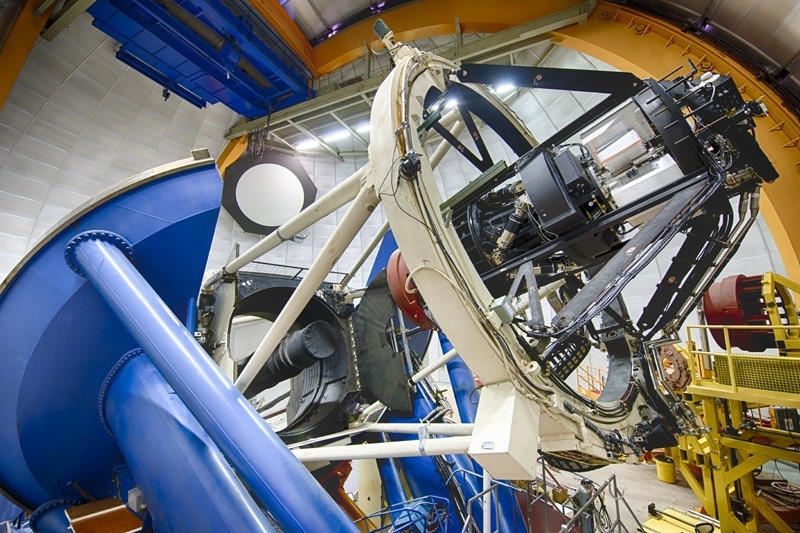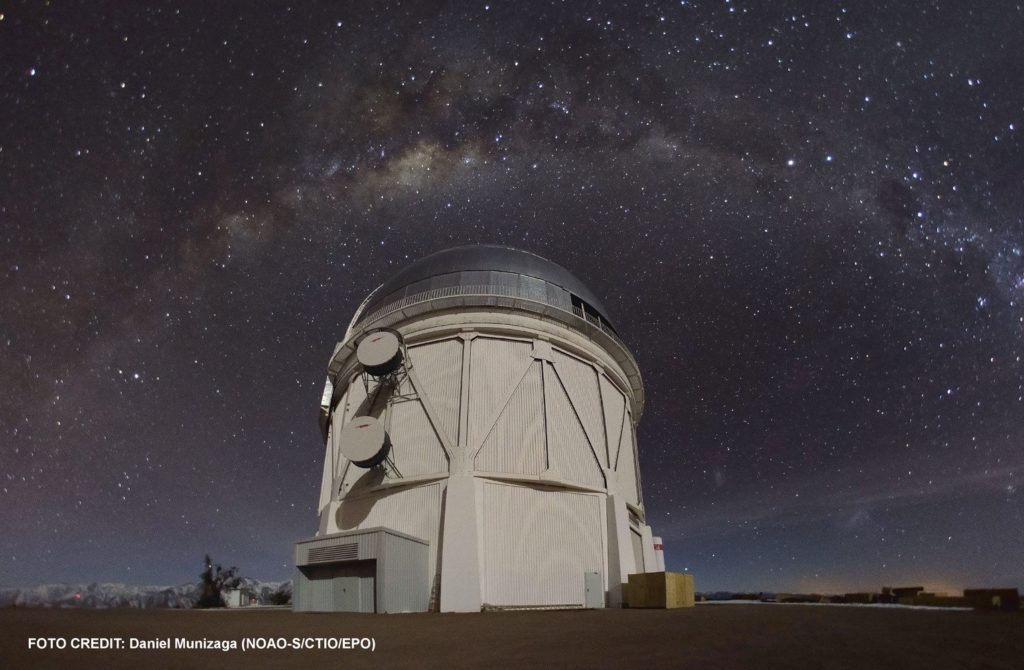
Dark Energy Survey (DES) scientists, including astronomers at Texas A&M University, are celebrating the release of the most accurate measurement to date of the present large-scale structure of the universe.
DES scientists unveiled their most recent findings in a presentation today (August 3) at the American Physical Society Division of Particles and Fields meeting at the U.S. Department of Energy’s (DOE) Fermi National Accelerator Laboratory. Their measurements of the amount and “clumpiness,” or distribution, of dark matter in the present-day cosmos were made with a precision that, for the first time, rivals that of inferences from the early universe by the European Space Agency’s orbiting Planck observatory, enabling scientists to understand more about the ways the universe has evolved over 14 billion years.
“This result is beyond exciting,” said Scott Dodelson of Fermilab, one of the lead scientists on this result. “For the first time, we’re able to see the current structure of the universe with the same clarity that we can see its infancy, and we can follow the threads from one to the other, confirming many predictions along the way.”
Most notably, this result supports the theory that 26 percent of the universe is in the form of mysterious dark matter and that space is filled with an also-unseen dark energy, which is causing the accelerating expansion of the universe and makes up 70 percent.

“I thought the discovery of dozens of dark-matter dominated dwarf galaxies orbiting the Milky Way was exciting, but this is really big news,” said Texas A&M astronomer Jennifer Marshall, a DES Builder and member of the survey’s management and science committees. “Ground-based measurements of the universe rarely can rival the precision of space-based projects, and that DES does just that is a testament to the hard work of the scientists and instrument builders across the world who have invested a huge amount of effort in this project.”
The new results released today draw only from data collected during the survey’s first year, which covers one-thirtieth of the sky. The data was captured by the DES’s primary instrument and imaging device, the 570-megapixel Dark Energy Camera (DECam), one of the most powerful in existence for which Texas A&M astronomer Darren DePoy served as the project scientist. Scientists on DES are using the camera to map an eighth of the sky in unprecedented detail during the five-year study, which runs through 2018.
Revered as the most powerful survey instrument of its kind, DECam is able to see light from more than 100,000 galaxies up to 8 billion light years away in each snapshot. A key sub-component of the camera — a spectrophotometric calibration system known as DECal that allows the camera to obtain very high precision brightness measurements of the objects it sees in the sky — was built within Texas A&M’s Charles R. ’62 and Judith G. Munnerlyn Astronomical Laboratory under the direction of DePoy and Marshall.
Astronomers Discover Earliest Ancient Dead Galaxy, Giving Pause to Modern Galaxy Evolution Theories
“We initially got involved with the Dark Energy Survey as the first project our instrumentation lab took on when it was founded in 2008,” Marshall said. “I have been fortunate to become more involved in the scientific productivity and the management of the project during the past few years, and it is incredibly satisfying to see such an impressive result come out of the work that was begun so many years ago.”
DECam was built and tested at Fermilab, the lead laboratory on the Dark Energy Survey. DePoy led the team that commissioned the enormous device, which is mounted on the National Science Foundation’s 4 meter Blanco telescope, part of the Cerro Tololo Inter-American Observatory in Chile, a division of the National Optical Astronomy Observatory. The DES data are processed at the National Center for Supercomputing Applications at the University of Illinois at Urbana-Champaign.
“It is amazing that the team has managed to achieve such precision from only the first year of their survey,” said National Science Foundation Program Director Nigel Sharp. “Now that their analysis techniques are developed and tested, we look forward with eager anticipation to breakthrough results as the survey continues.”
DES scientists used two methods to measure dark matter. First, they created maps of galaxy positions as tracers, and second, they precisely measured the shapes of 26 million galaxies to directly map the patterns of dark matter over billions of light years, using a technique called gravitational lensing.
To make these ultra-precise measurements, the DES team developed new ways to detect the tiny lensing distortions of galaxy images, an effect not even visible to the eye, enabling revolutionary advances in understanding these cosmic signals. In the process, they created the largest guide to spotting dark matter in the cosmos ever drawn (see image). The new dark matter map is 10 times the size of the one DES released in 2015 and will eventually be three times larger than it is now.
“When you look at the red and blue map, remember that the spots are over 100 million light years across, with red spots being areas of the local universe where there are just slightly more galaxies than in the blue parts,” said Nicholas Suntzeff, director of the Texas A&M astronomy program and a co-discoverer of dark energy. “But we now know that these spots came from tiny energy fluctuations at a time before the Big Bang — a time we call inflation — and that these fluctuations have now expanded to fill the universe we see today. Thus, when we look at the whole sky, we are also looking at the inside of some primal subatomic particle that existed a fraction of a second after the birth of the universe.”
DePoy notes that DES is also turning up other amazing results in its ongoing mission to map one-eighth of the universe for cosmological measurements. One example is a large number of companion galaxies to the Milky Way that can be used to measure the way in which our galaxy formed and changed over time, along with the history of star formation and creation of elements over time by stars. Marshall is among the leaders of the group of DES scientists working on these exciting results.
In addition to Marshall, DePoy and Suntzeff, Texas A&M astronomers and fellow George P. and Cynthia Woods Mitchell Institute for Fundamental Physics and Astronomy members Lucas Macri, Casey Papovich and Louis Strigari are full members of the 400-plus-member international DES collaboration that spans 26 institutions and seven countries as well as the gamut of science and engineering in the search for answers regarding the universe’s accelerated expansion. Texas A&M statistician James Long also is an external collaborator.
Read more on today’s announcement and its broader significance in the official press release from Fermilab.
View these results and others from the first year of the Dark Energy Survey online, and learn more about Texas A&M astronomy at http://astronomy.tamu.edu.
###
This story by Shana K. Hutchins originally appeared on the College of Science website.





